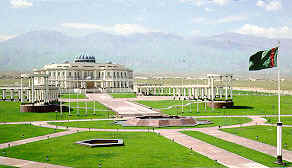
The National Museum of Turkmenistan

Technical parameters of the museum:
General area – 14563 sq.m
Exhibition area – 3171 sq.m
Number of exhibition halls – 7
Number of storage units – 33776
Designed for 2500 visitors a day
On the 12th of November the greatest museum complex in Turkmenistan and the Middle East opened its doors in Ashgabat, combining the collections of the former museums of history and ethnography, regional study and the arts.
About 500,000 exhibits are displayed in the new museum. It boasts a full collection of Turkmenistan’s most significant architectural finds of the XX century; a large number of ancient Turkmen carpets and rugs; examples of national dress and fabrics; traditional household equipment; musical instruments; weapons; jewelry; orders and medals, and historical documents. Its unique collection of paintings, drawings and sculptures includes not only Turkmen fine arts but masterpieces of some Russian and Western European artists of the nineteenth-twentieth centuries. The collection includes early paintings, water-colors and icons among its exhibits. Moreover the museum reveals the variety of Turkmenistan’s landscape; its floras and fauna, fossils and rare geological finds.
Let’s take a small excursion through the museum and its halls.
On the first floor, to the left of the centre of the building, where a sculpture of the state emblem is installed on a high foundation, is the HALL OF INDEPENDENCE, illustrating the modern development of the country, along with a range of costly presents given to Saparmurat Turkmenbashi – President of Turkmenistan, and donated by him to the museum.
The second floor is entirely dedicated to archeology and ethnography. The first three halls feature displays in chronological order. THE HALL OF ANCIENT HISTORY presents a collection of flint tools from the Mezolithic era (50 000 years B.C.), used by primitive people in Western Turkmenistan, along with Neolithic ceramics and ornaments from the first human settlements along the northern slopes of Kopetdag. There are also objects made from clay and metal/ semi-precious stones and bone, witnessing the high level of development of the early agricultural civilizations of Jeitun, Altyn-Depe, Namazg, Anau etc. They represent the northern complex of old-eastern most famous in Babylon and Assyria.
The place of honor is this hall is occupied by Margiana, a unique Bronze Age civilization discovered by archeologists in the Karakum desert to the north of the modern town of Bairamali which was a fertile delta of the river Murgab about 3000 years ago. There was a set of settlements with mighty towers and monumental sanctuaries.
THE HALL OF ANTIQUITY covers the eventful period of history from the Akheminidic period (YI-IY centures B.C.) to the first centuries A.D. Parphian culture II-I cent. B.C. dominates here which became the largest empire of the East, competing with Rome itself.
A full collection of ritons –special horn-like vessels made of ivory featuring magnificent art-are represented alongside a number of exhibits. All of them were found in Ashgabad’s suburbs, at excavations of Old Nisa – residence of Parphian kings from the Arshakid Dynasty. Marble sculptures and silver, gold and bronze items from Parphian Nisa are outstanding examples of art closely connected with the Hellenistic tradition.
In this hall one can see exhibits from other regions of antique Turkmenistan – from Khorezm (in the north), the Kushansk empire (along the Amu-Darya rive) and primarily from Merv, the largest archeological site in all Central Asia which has yielded a number of discoveries – from buildings to coins and tiny gems.
THE HALL OF THE MIDDLE AGES tells about the Sasanidic epoch which was linked to a new growth in the culture of the ancient Central Asian oases. Several Buddah images and a wonderful painted vase from Merv attract the eye in perticular.
Most of the exhibits in this hall date from the middle ages which came to Turkmenistan after the Arabian conquest in YII century. The heyday of this culture came will the Seldzuck empire (XI-XII cent.).
ETHNOGRAPHY is represented in two halls on the second floor and in one hall on the first floor. Between them is the giant carpet –“Saparmurat Turkmenbashi”. Its 266 square meters of classical Tekin design was woven by the collective of carpet-makers in just five months.
Household objects, women’s, men’s and children’s national costume, examples of old Turkmen weapons, musical instruments, hand-written books and displays of traditional life from the XYIII-beginning of XX centuries are displayed in the ethnographic halls.
Turkmenistan’s famous handcrafted carpets of dyed sheep’s wool are finest masterpieces of its national art. Dark red and brown shades dominate with ornaments and colors differing depending on the local traditions of Turkmen tribes and regions: Tekin, Iomud, Kerki, Gyzylayak etc.
The brightest examples of this tradition are embroidered fabrics and gilded silver jewelry featuring precious stones, stamping and engraving.
THE HALL OF NATURE completes the museum. Turkmenistan is very rich in mineral fossils and all their variety is represented in this hall of the museum. One can see fossils of the Paleozoic era and ammonite fossils which are millions of years old, mountain rock samples and representatives of Turkmen flora and fauna including andemics a of kind only found in Turkmenistan.
But contrary to most people’s idea of a museum as being concerned only with exhibitions we should remember the displays are actually only a small part of the facility’s work.
First of all, the museum is a scientific research institute whose functions include acquisition, storage, study and popularization of important samples of natural history and physical and spiritual culture – primary sources of knowledge about the development of nature and society.